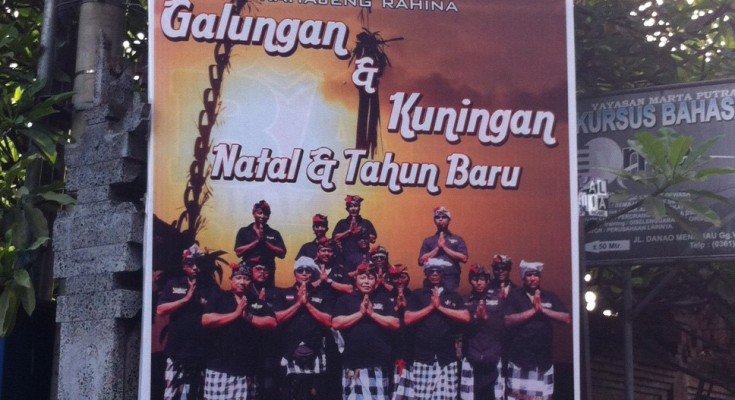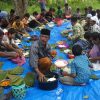Some time ago I posted an article on Lattudes.nu about billboards displaying best wishes for the celebration of the Balinese religious ceremonies Galungan & Kuningan. Most of those billboards were erected by political parties showing the chair of the party at the national level together with the chair of the same party at the provincial or district level. These billboards had a clear message: Hindu Balinese, vote for our party leaders in the coming general election!
Since that time I took a closer look at billboards in the week prior to Galungan and Kuningan, the period when the entire island is adorned with decorated bamboo poles called penyor. The recent Galungan and Kuningan ceremonies took place on Wednesday 18 and Saturday 27 December 2014. This time the most numerous were those of several large ormas (organisasi masyarakat) in Bali, consisting of thousands of members. Very few featured emblems of political parties and very few only local political leaders. Most prominent were the billboards put up by Laskar Bali (the army of Bali), Baladika and Pemuda Bali Bersatu which always feature the organization’s emblems. These billboards were posted at many junctions in Bali’s capital Denpasar and along its major streets. In between Galungan and Kuningan my family made a trip to Candidasa in East Bali, taking a detour by a scenic road via Sidemen, Rendang and Klungkung on our way back. Alongside this road we also encountered many billboards, so I suppose they must have been placed throughout the island. What are the messages these billboards bring across?
Male power
The most striking feature of the billboards: if humans figure on them, they are exclusively male. Several show a large group of men, often clothed in black, sometimes combined with a black and white checquered cloth, the combination of colours representing good and evil. Picture 1. Others show pictures of the leaders of the group, most frequently the men leading Laskar Bali and Baladika (Picture 2 & 3).
Apparently some groups wish to emphasize their image of ‘strong men’. I encountered in a village a billboard which I find quite funny. It comes from a group by the name keluarga besar badak jeruji, showing in profile the head of a rhinoceros (badak) with ferociously bared teeth in combination with an out-of-proportion muscular arm (picture 4). Also catching my attention was the name of another group: keluarga besar bulldog, Buleleng dogen. I assume that the choice of this name roots in the idea that a bulldog is a fierce animal and therefore appropriate to convey the image of male prowess and aggressiveness (picture 5). Why this billboard from a group originating from the northern district of Bali, Buleleng, was placed on a busy street in Denpasar is a mystery to me.
Guardians of Bali?
The website of Laskar Bali as well as the underdeveloped facebook accounts of Baladika and Pemuda Bali Bersatu all state that defending Bali is their foremost goal. A leader of Balidika formulated it as keeping Bali safe ‘against various threats and disturbances’ (berbagai ancaman dan gangguan). This explains why the images projected on the billboards feature groups of vigilant men: women apparently do not play a role this endevour. The sheer omnipresence of the billboards underlines that Balinese men are a force to reckon with. Indeed, these vigilante groups have been involved by the government of Bali, for example to secure the Miss World Competition and the APEC conference held in Bali in 2013. Apparently, the national police force was considered not entirely up to the task.
The positioning of billboards, however, also tells another well-known story: the story of fierce rivalry between the vigilante groups. The positioning of the billboards demarcates the territory claimed by Laskar Bali and Baladika. This is evident in Denpasar, where in certain areas billboards of only one of the groups were in sight. This can be read as an ill omen. Violent clashes between the vigilante groups – also often referred to as gangs of s-called ‘free men’ (freman) – have erupted regularly over the years and have been extensively covered in local, national and also Australian media. The billboards indicate that bloody fights between the groups may very well occur again. So much for keeping Bali safe!
Token tolerance?
Remarkable is also that all the billboards presented in this article (and others) include best wishes for Christmas and New Year (Selamat Hari Natal dan Tahun Baru). Christmas is not part of Hindu-Balinese culture and neither is the celebration of the New Year according to the western calender, which by the way is commonly used in Indonesia today. Perhaps the Balinese vigilante groups are of the opinion that it is opportune to show their respect for other religions. After all, Bali is part of multi-ethnic and multi-religious Indonesia and the Hind-Balinese are a religious minority in the country. I look forward to the next series of billboards in July 2015. Will those billboards include best wishes for the Muslim community in the country? Because Idul Fitri will be celebrated on 20 or 21 July and – like Christmas last year – just in beween the Hindu-Balinese Galungan and Kuningan holy days.
Gangs such as the notorious “Laskar Bali”, or “Bali Army”, dominate the yard. Drugs are freely traded and most things, including a bigger cell, can be bought for the right price. Many who arrived clean eventually find their way into drug addiction.















